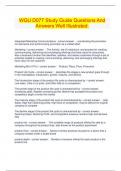WGU D077 Study Guide Questions And
Answers Well Illustrated.
Integrated Marketing Communications - correct answer. coordinating the promotion
mix elements and synchronizing promotion as a unified effort
Marketing - correct answer. The Activity, set of institutions, and process for creating,
communicating, delivering and exchanging offerings that have value for consumers.
Also a business function that identifies, satisfies, and retains customers through a set of
activities related to creating, communicating, delivering, and exchanging offerings that
have value for the customer.
Marketing Mix (4 P's) - correct answer. Product, Place, Price, Promotion
Product Life Cycle - correct answer. describes the stages a new product goes through
in the marketplace: introduction, growth, maturity, and decline
The Introduction stage of the product life cycle is characterized by - correct answer.
Low sales, Little or no profit, and Often little to no competition
The growth stage of the product life cycle is characterized by - correct answer.
Increasing sales, Rapidly increasing profits, Market has accepted the product and
competitors begin to enter the market
The maturity stage of the product life cycle is characterized by - correct answer. High
Sales, High then declining profits, High level of competition, may be difficult for original
company to compete
The decline stage of the product life cycle is characterized by - correct answer.
Declining Sales, Declining Profit, and Competitive pressure remains high and demand
falls
product mix - correct answer. The complete range of products offered for sale by a
company throughout its product lines, also known as the product assortment
product lines - correct answer. Series of similar products focused on a sector that a
company creates under a single brand
product depth - correct answer. Number of versions offered for each product in the
product line
, product width - correct answer. The number of different product lines, or series of
products a company offers
price skimming - correct answer. Intentionally pricing a new product offering high with
the intention of lowering it over time as competition grows, particularly in the case of a
unique offering with little or no competition at the outset (Pricing Strategy)
penetration pricing - correct answer. Intentionally pricing a product lower than the
market price to gain market share in a new market (Pricing Strategy)
leader pricing - correct answer. Pricing products below market price to attract
customers to a store where they would not otherwise shop (Pricing Strategy)
prestige pricing - correct answer. Raising the price of a product to increase the
perception of its value (Pricing Strategy)
Bundling - correct answer. Grouping related products together and pricing them as a
single product. (Pricing Strategy)
Competitive pricing - correct answer. Setting the price for a product or service relative
to competitors (Pricing Strategy)
Advertising - correct answer. Any paid form of nonpersonal promotion by an identified
sponsor
Personal selling - correct answer. A face-to-face presentation to a prospective buyer,
often based on long-term relationships.
Sales promotion - correct answer. Marketing activities that stimulate consumer buying,
including coupons and samples, displays, shows and exhibitions, and demonstrations.
Public relations - correct answer. The linking of organizational goals with key aspects
of the public interest and the development of programs designed to earn public
understanding and acceptance. Public relations can include lobbying, publicity, special
events, internal publications, and media such as a company's internal television
channel.
Social media - correct answer. The use of social media platforms such as Facebook,
Twitter, Pinterest, Instagram, and various blogs to generate "buzz" about a product or
company.
E-commerce - correct answer. The use of a company's website to generate sales
through online ordering, information, interactive components such as games, and other
elements of the website.




